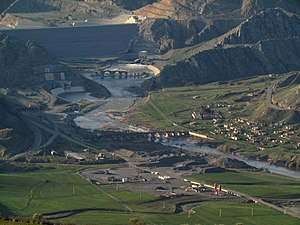胡達費林橋
| 胡達費林橋 | |
|---|---|
| پل خداآفرین(波斯文) Xudafərin körpüsü(阿塞拜疆文) Խուդաֆերինի կամուրջ(亞美尼亞文) | |
 | |
| 座標 | 39°09′00″N 46°56′30″E / 39.15000°N 46.94167°E座標:39°09′00″N 46°56′30″E / 39.15000°N 46.94167°E |
| 跨越 | 阿拉斯河 |
| 地圖 | |
 | |
胡達費林橋,位於高加索地區阿拉斯河上的兩座建於中世紀的聯拱橋。胡達費林橋分為相互獨立的兩座,均處於胡達費林大壩下游不遠處,兩橋相距約800米,下游的東橋仍可以使用,而上游的西橋已經毀壞。兩橋均呈東北-西南方向,所在河段為伊朗與阿塞拜疆兩國的國界,北側屬於阿塞拜疆傑布拉伊爾區,距離最近的村莊為胡達費林村;南側為伊朗東阿塞拜疆省的胡達費林縣,距離最近的村莊為薩里賈盧村。
結構[編輯]

東橋共有15個拱洞,長約200米,寬4.5米,距河面的最大高度為10米,由鵝卵石和燒製方磚建成,而且使用了大量的花崗岩。[1]東橋最大的橋洞的跨度為8.70米,最小的也有5.80米。
西橋原有11個拱洞,長約130米,寬6米,距河面的最大高度為12米,現僅存中間的三個半圓形的拱洞,故又稱為「斷橋」("synyg kyorpju"),該橋由石灰岩質的石磚砌成。[1]
歷史[編輯]

14世紀波斯歷史學家哈馬達拉·穆斯陶菲·加茲維尼認為胡達費林橋始建於伊斯蘭曆15年(公元637年),由先知穆罕默德的朋友伯克爾·本·阿卜杜拉建造。[2]:137此後曾經歷了多次的維修和重建。俄羅斯東方學者弗拉基米爾·米諾爾斯基則認為,胡達費林橋建於11世紀初沙達德王朝埃米爾法德勒·本·穆罕默德在位期間。[3]
但現代科學家認為,實際的建造時間還要晚一些,東橋建造於12世紀的伊爾代尼茲王朝時期,西橋重建於13世紀的伊爾汗國時期[2]:137。胡達費林橋曾多次毀於洪水破壞,東橋最近的一次大修是在18世紀。對於為何在東橋運作時重建西橋,可能是與伊爾汗國為應對與金帳汗國的戰事,而調遣大量軍隊通過胡達費林前往北方有關。[1]
20世紀初,為阻斷南北阿塞拜疆之間的聯繫,蘇聯和伊朗共同決定毀掉了西橋的大部分,僅餘中間3個橋洞。[2]:136從此,西橋在當地有了第二個名字——「斷橋」(Sınıq körpü)。
胡達費林橋處在古代絲綢之路上,曾是當地的交通要衝,不僅往來商旅,很多軍隊調動和民族遷徙也都途徑這裏。[4][1]
圖集[編輯]
-
阿塞拜疆郵票上的西橋
-
阿塞拜疆郵票上的西橋
-
阿爾察赫10德拉姆紙幣上的西橋
-
阿塞拜疆郵票上的東橋
參考[編輯]
- ^ 1.0 1.1 1.2 1.3 Khudaferin Bridges, Azerbaijan. Advantour. [2016-09-06]. (原始內容存檔於2019-12-07).
- ^ 2.0 2.1 2.2 C. Qiyasi – Nizami dövrünün memarlıq abidələri(尼扎米時代的建築), Bakı, İşıq, 1991
- ^ V. MINORSKY. Studies in Caucasian history. 1953. "The building of a bridge on the Araxes in 421/1030 is a hint at the extent of Fadl's dominions in the south. The bridge was a symbol either of his solicitude for the development of trade, or more probably of his designs against Azarbayjan. As explained in note 8 (to the text), I take it as more probable that Fadl's bridge was that of Khudafarm which connects the central portions of the two mountainous tracts: to the north of the Araxes, the present-day Soviet Qara-bagh; and to the south of this river, the Persian Qaraja-dagh. According to the Nuzhat al-Qulub, p. 84, one of the districts of Qaraja-dagh bore the name *Gildn-i Fadlun and consisted of so villages. This suggests that Fadl had expanded to the southern bank of the Araxes. From this region he could threaten the Rawwadis whose central axis was on the line Ahar-Tabriz. It is likely that Fadl was attracted by the eastern Azarbayjan, then lying masterless. An ode of Qatran in Kasravi, II, 93, indicates that the Rawwadis also had ambitions in the direction of Mughan. For all these reasons a bridge on the Araxes (at Khudafarin?) was a useful convenience for Fadl. "
- ^ Худаферинские мосты (Xudafərin körpüləri) (rusca). [2016-09-07]. (原始內容存檔於2020-10-19).






